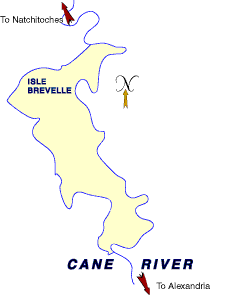Isle Brevelle
by Dr. H.F. Gregory
The term "Creole" comes from a Spanish word meaning "born of the New World." It was a label to sort colonials and their culture from that of native Europeans. The ensuing mix of cultures and races in the New World made them unique - it made them Creole.
By the 1780s, such a Creole community began on the Red River. A place of rich alluvial lands, covered with dense hardwood forests, it was already being transformed into a series of plantations by the eighteenth century. Families with mixed French, Spanish, Indian, and African roots were building homes, a church, and families - a true Creole way of life. The island trapped between Cane River and Bayou Brevelle, was named for a French trader and his Caddo Indian wife.
In 1806 the American explorer, Thomas Freeman, described the settlement well:
Tobacco, indigo, and cotton were all grown on the land. Divided up among numerous heirs, Spanish land grants became family plantations. The French arpent system divided the land, front to back, and homes were built on the higher land, at the river's edge.
So it is today. American landscapes are varied, but few others are as rich as this one. Planters built "Big Houses" in the West Indian raised cottage style, alongside more humble posts in the ground and bousillage cabins and houses. Slave cabins, often built of hewn logs and bousillage, were gradually transformed into tenant houses and were later replaced by shotgun houses. Contemporary visitors can find and see the history of the community, as well as the maintenance of family and culture, at Isle Brevelle. In a land of change, it offers a balanced continuity. Like all of modern America, this area has seen major changes, but a deep respect for land and people have held the line village together. As such, it has captured historians, authors, and artisans, many of whom belong to the community.
This is a riding tour, designed for automobile or bus. Travelers will find much to see, people who are private, and places of great beauty. Visitors are invited to stop at the church, at Melrose Plantation, and the Badin Roque house. Remember, if you will, that people live and work here. It is a real place, not a staged place. You are asked to be respectful, and to help the community survive.
In nearby Natchitoches, Louisiana, the Creole Heritage Center at Northwestern State University offers more information on Creole culture, as does the Cane River National Heritage Area office.
